比较结构的翻译
- 格式:ppt
- 大小:84.00 KB
- 文档页数:19

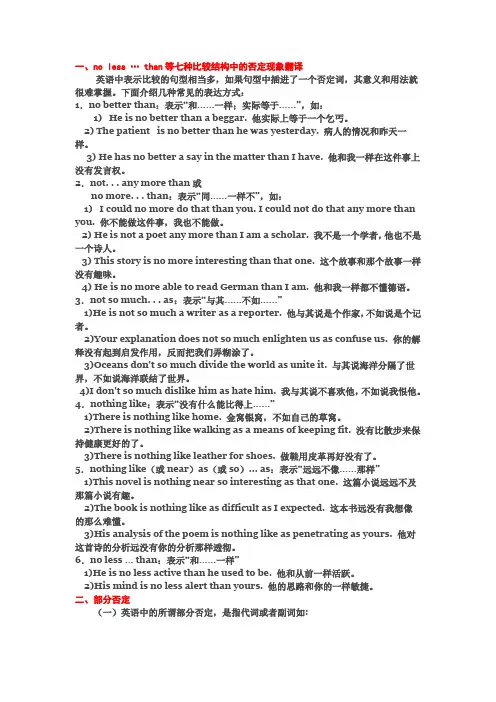
一、no less … than等七种比较结构中的否定现象翻译英语中表示比较的句型相当多,如果句型中插进了一个否定词,其意义和用法就很难掌握。
下面介绍几种常见的表达方式:1.no better than:表示“和……一样;实际等于……”,如:1) He is no better than a beggar. 他实际上等于一个乞丐。
2) The patient is no better than he was yesterday. 病人的情况和昨天一样。
3) He has no better a say in the matter than I have. 他和我一样在这件事上没有发言权。
2.not. . . any more than或no more. . . than:表示“同……一样不”,如:1) I could no more do that than you. I could not do that any more than you. 你不能做这件事,我也不能做。
2) He is not a poet any more than I am a scholar. 我不是一个学者,他也不是一个诗人。
3) This story is no more interesting than that one. 这个故事和那个故事一样没有趣味。
4) He is no more able to read German than I am. 他和我一样都不懂德语。
3.not so much. . . as:表示“与其……不如……”1)He is not so much a writer as a reporter. 他与其说是个作家,不如说是个记者。
2)Your explanation does not so much enlighten us as confuse us. 你的解释没有起到启发作用,反而把我们弄糊涂了。
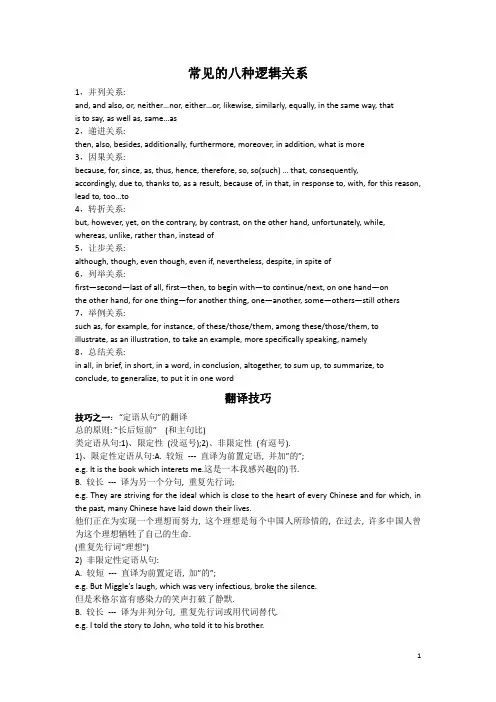
常见的八种逻辑关系1,并列关系:and, and also, or, neither…nor, either…or, likewise, similarly, equally, in the same way, thatis to say, as well as, same…as2,递进关系:then, also, besides, additionally, furthermore, moreover, in addition, what is more3,因果关系:becaus e, for, since, as, thus, hence, therefore, so, so(such) … that, consequently, accordingly, due to, thanks to, as a result, because of, in that, in response to, with, for this reason, lead to, too…to4,转折关系:but, however, yet, on the contrary, by contrast, on the other hand, unfortunately, while, whereas, unlike, rather than, instead of5,让步关系:although, though, even though, even if, nevertheless, despite, in spite of6,列举关系:first—second—last of all, first—then, to begin with—to continue/next, on one hand—onthe other hand, for one thing—for another thing, one—another, some—others—still others7,举例关系:such as, for example, for instance, of these/those/them, among these/those/them, to illustrate, as an illustration, to take an example, more specifically speaking, namely8,总结关系:in all, in brief, in short, in a word, in conclusion, altogether, to sum up, to summarize, to conclude, to generalize, to put it in one word翻译技巧技巧之一:“定语从句”的翻译总的原则: ”长后短前” (和主句比)类定语从句:1)、限定性(没逗号);2)、非限定性(有逗号).1)、限定性定语从句:A. 较短--- 直译为前置定语, 并加”的”;e.g. It is the book which interets me.这是一本我感兴趣(的)书.B. 较长--- 译为另一个分句, 重复先行词;e.g. They are striving for the ideal which is close to the heart of every Chinese and for which, in the past, many Chinese have laid down their lives.他们正在为实现一个理想而努力, 这个理想是每个中国人所珍惜的, 在过去, 许多中国人曾为这个理想牺牲了自己的生命.(重复先行词”理想”)2) 非限定性定语从句:A. 较短--- 直译为前置定语, 加”的”;e.g. But Miggle's laugh, which was very infectious, broke the silence.但是米格尔富有感染力的笑声打破了静默.B. 较长--- 译为并列分句, 重复先行词或用代词替代.e.g. I told the story to John, who told it to his brother.我把这件事告诉了约翰, 约翰(他)又告诉了他的弟弟.(重复先行词约翰或用代词”他”替代)技巧之二:“同位语从句”的翻译四种翻译方法:1)、译为独立的句子;2)、“名转动, 从变宾”;3)、“这、那复指”;4)、主谓词组作定语.1)、译为独立的句子:适用条件: 同位语较长, 或以插入语形式出现,或同时满足以上两者.解决办法: 把同位语从句译为独立的句子, 用”认为……”, “就是……”, “即……”, 冒号, 破折号或括号等引出.e.g. My grandfather was obviously wrong in his opinion that a woman`s place was in the home. 我祖父的观点, 即所谓女人的位置应该在家里, 很明显是错误的.2)、“名转动, 从变宾”:适用条件: 先行词在主句中作宾语.解决办法: 把同位语从句修饰的名词转译为动词, 而把同位语从句译成宾语.e.g. He expressed the hope that he could visit our city again.他希望他能再次访问我们的城市.3)、“这、那复指”:适用条件: 先行词在主句中作主语.解决办法: 先把同位语从句的内容翻译出来,在后面用”这”或”那”等代词复指同位语从句的内容, 使其与句子主体连接起来.e.g. The dictum that the style is the man is known to most of us.文如其人, 这句名言为我们大多数人所熟悉.4)、主谓词组作定语:适用条件: 先行词在主句中作主语.解决办法: 把同位语从句翻译成主谓词组, 放在先行词前面充当定语.e.g. Yet, from the beginning, the fact that I was alive was ignored.然而, 从一开始, 我仍然活着的事实就被忽略了.技巧之三“定语转译”1) 定语转译为谓语(动词):e.g. Neutron has a mass slightly larger than that of proton.中子的质量(是)略大于质子的质量.2) 定语转译为状语:适用条件: 定语所修饰的名词或名词性词组在主句中作为动词或介词的宾语出现.e.g. Scientists in that country are now supplied with necessary books, equipment and assistant that will ensure success in their scientific research.两种译法:1) 定语从句”长后短前”译法(重复先行词):现在已给该国科学家提供了必要的图书、仪器和助手, 这些将保证科研工作的成功.2) “定语转译”译法(转译为目的状语):现在已给该国科学家提供了必要的图书、仪器和助手, 以保证科研工作的成功.技巧之四:“后置定语的翻译”总的原则: “英语定语多后置, 汉语定语多前置” 最常见的两种长后置定语的翻译方法:1) 介宾形式的长后置定语;2) 非谓语动词形式的长后置定语.1) 介宾形式的长后置定语:适用条件: 由多个介宾短语并列构成, 通常为了符合英文的行文习惯, 介宾短语表示的范围一般为由小到大.解决方法: 按照汉语的行文习惯, 变换顺序为由大到小.e.g.1 In fact, it is difficult to see how journalists who do not have a clear grasp (of the basic features) (of the Canadian Constitution) can do a competent job on political stories. (2007年, 49题)e.g.2 But his primary task is not to think about the moral code, which governs his activity, any more than a businessman is expected to dedicate his energies to an exploration (of rules) (of conduct) (in business).(2006年, 49题)e.g.3 But the idea that the journalist must understand the law more profoundly than an ordinary citizen rests on an understanding (of the established conventions and special responsibilities) (of the news media.) (2007年, 48题)2) 非谓语动词形式的长后置定语:适用条件: 由非谓语构成的短语结构, 其逻辑上的主语就是被修饰的名词性结构.解决方法: 将其单独译为一个分句, doing表示主动/正在, done表示被动/完成,to do表示意愿/将来. e.g.4 On the other hand, he did not accept as well founded the charge (made by some of his critics) that,while he was a good observer, he had no power of reasoning.(2008年, 48题)技巧之五:“宾语从句的翻译”总的原则: 英文中的谓语动词、非谓语动词和介词都可以带宾语, 也都可以带宾语从句.最常见的两种宾语从句类型:1) 普通宾语从句;2) it作形式宾语的宾语从句.1) 普通宾语从句:一般不改变原句顺序, 即采用“顺译法”.e.g.1 I don`t know how he swam across the river.我不知道他是怎么游过那条河的.e.g.2 They believe that they will surely win the game.他们相信他们肯定会赢得这场比赛.e.g.3 He would remind people again that it was decided not only by himself but by lots of others. 他再三提醒大家, 决定这件事的不只是他一个人, 还有其他许多人.2) it作形式宾语的从句:翻译时it一般不必译出, 而真正的宾语从句一般可按原文顺序译出, 即采用“顺译法”.e.g.4 I made it clear to them that they must hand in their papers before 10 o`clock in the morning.我向他们讲得很清楚, 他们必须在上午十点之前提交论文.但有时候, 考虑到汉语的表达习惯, 译文中需要将真实宾语提前:e.g.5 I regard it as an honor that I am chosen to attend the meeting.被选中参加会议, 我感到很荣幸.采用此种译法时, 有时需要用“这”, “它”等对真实宾语进行重复.e.g.6 We consider it absolutely necessary that we should open our door to the outside world.打开国门, 实行开放, 我们认为这是绝对必要的. (it翻译为“这”)技巧之六:“表语从句的翻译”总的原则: 名词性从句的一种, 既可顺译, 也可逆译, 既可以与主句译为一个共同的简单句,也可以单独译为一个分句, 要根据具体语境判断.1) 与主句合译为一个简单句:e.g. Time factor is what we have to take into consideration.时间因素是我们不得不考虑的.2) 单独译为一个分句:e.g. The question which worries everyone today is how long will these fuels last.今天人人都担心的问题是: 这些燃料能用多久.几种常见表语从句类型:1) that (this) is why…:解决方法:a) 如果采用顺译法, 可译为“这就是为什么… (的缘故)”;b) 如果采用逆译法, 可译为“…的原因就在这里”, “…的理由就在于此”.e.g.1 That is why practice is the criterion of truth and why the standard of practice should be first and fundamental in the theory of knowledge.所谓“实践是检验真理的标准”, 以及所谓“实践的标准应该是认识论首要的和基本的观点”,(这两种观点的理由)就在于此.2) this (it) is because:解决方法:此句型一般采用“顺译法”, 可译为“这是因为…(的缘故)”.e.g. This is because the direct current flows in a wire always in one direction.这是由于直流电在导线中总沿着一个方向流动的缘故.3) this is what:解决方法:a) 如果采用“顺译法”, 通常译为“这就是… (的内容)”;b) 如果采用“逆译法”, 通常译为“…就是这个道理”.e.g. This is what we have discussed today.这就是今天我们讨论的内容.4) this (that) is where:解决方法:a) 如果采用“顺译法”, 通常译为“这就是…的地方”;b) 如果采用“逆译法”, 可译为“…的地方就在于此”.e.g. This is where I disagree with you.这就是我不同意你的地方.技巧之七:“同位语+ 后置修饰结构”总的原则: 此结构中同位语一般为一个单词, 而后置修饰语的结构一般都比较复杂, 可以是定语从句, 也可以是分词或不定式结构.(05年, 47题, 48题).解决方法:将这种结构译为一个独立的分句, 同位语在分句中作主语或宾语.e.g.1 You might say that this is a problem of their own making, one that they could avoid simply changing their habits and hunting by day.也许你会说这是他们自己造成的问题, 通过改变生活习性在白天出来捕食, 它们可以轻松解决这一问题.e.g.2 And yet most of us have had the experience of having to adjust to sleeping in the mountains or the country-side because it was initially “too quiet”, an experience that suggests that humans are capable of adapting to a wide range of noise levels.我们大多数人都有过这样的经历: 如果在深山或者乡村睡觉, 必须作一些调整才能睡得着, 因为这些地方起初“太安静”了. 这一例子说明人类有能力去适应各种不同程度的噪音.技巧之八:“名词转译为动词”总的原则: 英语多用名词少用动词;汉语多用动词少用名词.1) 英语中由动词派生的名词和具有动作意义的名词, 很多时候可以转译为汉语中的动词:e.g.1 Rocket have found application for the exploration of the universe.火箭已经用来探索宇宙.e.g.2 The sight and sound of our jet plane filled me with special longing.看到我们的喷气式飞机, 听见隆隆的机声, 我感到特别神往.2) 英语中有些表示职业的名词(通常后缀为-er), 有时在句中并不表示身份和职业, 而是含有较强的动作意味或说明具有某种品质, 在汉语中没有恰当的对应名词时, 往往可译为汉语中的动词.e.g.1 As a successful career woman, she is also a good cook.身为一名成功的职业女性, 她做菜也做得很好.e.g.2 Some of my classmates are good singers.我同学中有些人唱歌唱得很好.技巧之九:“状语的翻译”总的原则: 状语两大类: “从句类” ; “非从句类”最常见的两种非从句类型:1) 副词作状语;2) 短语作状语(介宾, 不定式).总的处理原则:1) 副词作状语(较短):直接译为汉语中的状语.2) 短语作状语(较长):将其译为一个分句.e.g.1 With a slight gesture she summons the Indian boy standing behind her chair, and whispers to him.她向站在她座位后面的印度男仆微微作了个手势, 示意他过来, 对他耳语一番.e.g.2 Flooded with calls, the company is maximizing profits by handling in city runs.叫车的人太多了, 公司便只接来往于市内的生意, 这样可以使利润最大化.技巧之十:“状语从句的翻译”总的原则: 状语从句分为两大类:“while型”和“非while型”.while引导的让步状语从句:(状语从句翻译中的难点)(2007, 50题; 2009, 48题; 2008, 48题;)难点: 判断while的不同含义.While I admit I did it, I didn`t intend to.尽管我承认是我做的这件事, 但我并不是有意的.“非while型”的两种基本翻译方法:1) 顺译法;2) 逆译法.1) 顺译法:e.g.1 When the storm had passed, we continued our way.暴风雨过后, 我们继续赶路.e.g.2 We can chop and change till we get someone who suits.我们可以变来变去, 直到我们找到一个合适的人.2) 逆译法:起因: “英语状语多后置, 中文状语多前置”.方法: “颠倒顺序(为了符合中文习惯)”e.g. The students stood up before the teacher had come in.老师还没进来学生就站起来了.技巧之十一:“非谓语动词作状语”总的原则: 非谓语动词包括不定式, 动名词和分词, 非谓语结构在句中可作除谓语之外的多种句子成分. 其中非谓语动词作状语时, 其功能相当于状语从句, 修饰谓语动词.解决方法:与状语从句一样, 非谓语结构也可以用来表示时间, 原因, 结果, 条件, 让步, 方式等. 翻译时可译为一个分句, 并可增译相应连词来表明其与主句之间的逻辑关系.e.g.1 Coming from Iran, I have a keen interest in Middle Eastern science.因为我来自伊朗, 所以对中东的科技有浓厚的兴趣.e.g.2 Managed badly, email can be a waste of valuable time.如果管理不当, 电子邮件会浪费我们的宝贵时间.技巧之十二“被动语态的翻译”总的原则: 英语多被动, 汉语少被动.最常见的两种翻译方法:1)直译为汉语的被动句;2)转译为汉语的主动句.1) 直译为汉语的被动句:适用条件: 着重表达被动含义的英语被动句.解决方法: 直接翻译为汉语中的被动句, 汉语中表达被动意义的语言工具主要有”被, 受, 遭, 让, 给, 由, 把, 得到,受到, 加以, 得以, 为…所, 由…来”等e.g.1 The minister was found to have appropriated government money.部长被发现挪用公款.(部长挪用公款被发现.)e.g.2 He was praised by his teacher.他得到了老师的表扬.(他被老师表扬了.)e.g.3 Problems should be resolved in good time.问题应及时加以解决.(问题应得到及时解决.) (问题应被及时解决.)2) 转译为汉语的主动句(六种译法):A. 保存原句主语;B. 原文主语转译为宾语;C. 增译主语;D. 译成汉语”无主句”;E. 译成汉语”判断句”;F. 被动句型”It + 被动语态+ that”的翻译.A. 保存原句主语:适用条件: 主语为无生命的名词, 且句中不出现由by引导的行为主体.解决方法: 被动句主语直接变为主动句主语.e.g.1 Water can be changed from a liquid into a solid.水能从液体变成固体.B. 原文主语转译为宾语:适用条件1): 句中由by引出动作的施动者.适用条件2): 介词短语构成的状语引出施动者.解决方法: 施动者变主语, 原主语变宾语.e.g.2 Heat and light can be given off by this chemical change.这种化学反应能放出热和光.e.g.3 Communication satellites have already been used for living transmission in our country. 我国已将通讯卫星用于实况直播.C. 增译主语:适用条件: 句中未出现表示行为的主体.解决方法: 适当增添一些泛指性的主语, 如”人们”、”有人”、”大家”、’’我们”等.e.g.4 The issue has not yet been thoroughly explored.人们对这一问题迄今尚未进行过彻底的探索.D. 译成汉语”无主句”:适用条件: 有些被动句不需要或者无法说出行为的主体.解决方法: 翻译成汉语中的”无主语句型”, 原句中的主语译成宾语.e.g.5 Measurements have been taken to prevent the epidemic from spreading.已经采取了措施防止这种流行病的蔓延.E. 译成汉语”判断句”:适用条件: 有些被动句不突出强调被动动作,而着重对事物的状态、过程和性质等加以描述, 其作用与”主系表”结构类似.解决方法: 翻译成汉语中的”判断句”, 经常采用”是…的”句式.e.g.6 Printing was introduced into Europe from China.印刷术是从中国传入欧洲的.F. 被动句型”It + 被动语态+ that”的翻译:适用条件: It作形式主语, that引导的从句是真正主语.解决方法: 1) 增译泛指性主语, 如“我们”, “人们”, “大家”, “有人”等等.2) 译成无主语的汉语句子.e.g.7 It is stressed that the field of science may be divided into two major areas: natural science and social science.有人强调说, 科学的范畴可以分成两个主要领域: 自然科学和社会科学.e.g.8 It should be pointed out that this process is oxidation.应该指出, 这一过程就是氧化.技巧之十三:“形式主语”的翻译总体原则:先译真实主语, 后译形式主语. (“先真后假”)三种方法:1) 按原句顺序翻译;2) 增译主语;3) 调整语序.1) 按原句顺序翻译:两种情况:A. 真实主语是”不定式短语(to do)”或”动名词短语(doing sth.)”, 整句可译成无主语的句子.e.g. It is no exaggeration to say she is the best mother in the world.可以毫不夸张地说她是世上最好的母亲.B. 真实主语为一个从句, 可将形式主语和谓语译为一个短语, 而将主语从句译为句子的主干.e.g. It goes without saying that these waves travel at the speed of light.显然, 这些波是以光速传播.2) 增译主语:适用条件: 形式主语部分为被动句.解决办法: 根据句意或上下文增译出主语, 或增译泛指性主语”我们”、”人们”、”大家”、”有人”等等.e.g. It was incorrectly believed that current flowed from positive to negative.人们错误的认为电流是由正极流向负极的.3) 调整语序:适用条件: 真实主语为主语从句或其他较长的结构时.解决办法:A. 将真实主语恢复到主语位置.e.g. It was rather hard to bring up the child on her own.她独自一人抚养孩子十分不容易.B. 有时为了说明强调并使汉语句子通顺, 可对主语进行重复.e.g. It seemed inconceivable that the pilot could have survived the crash. 驾驶员在飞机坠毁之后竟然还活着, 这简直难以置信.技巧之十四:“比较结构”的翻译总体原则: 比较结构多英式思维, 很难字面翻译.解决方法:熟记含义的前提下灵活运用.more than:1) more than + 名词/动名词/名词性从句:译法: "不仅仅, 超过, 不同于"e.g. Deliberate practice entails more than simply repeating a task.刻意练习不仅仅是简单的重复一项任务.2) more than + 动词:译法: "不仅仅, 岂止是, 极大地, 十分的"e.g. They may teach very well and more than earn their salaries.他们可以教得很好, 而且不仅仅是为了挣薪水.3) more than + 形容词/副词:译法: "非常, 不止于"e.g. I am more than willingly to go out with you.我非常愿意和你一起出去.4) more than + 从句:译法: "并非, 不是"e.g.1 At least you enjoy yourself, which is more than I did.至少你玩儿得很开心, 但是我却没有.e.g.2 The beauty of Chengdu is more than words can describe.成都的美是语言不能形容的.。
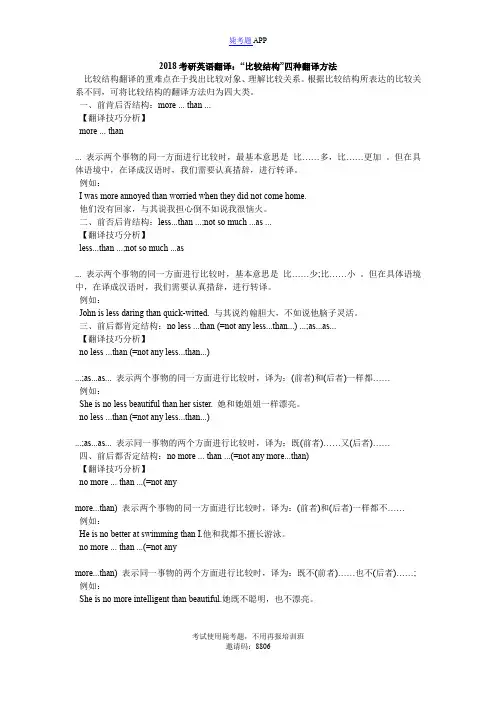
毙考题APP2018考研英语翻译:“比较结构”四种翻译方法比较结构翻译的重难点在于找出比较对象、理解比较关系。
根据比较结构所表达的比较关系不同,可将比较结构的翻译方法归为四大类。
一、前肯后否结构:more ... than ...【翻译技巧分析】more ... than... 表示两个事物的同一方面进行比较时,最基本意思是比……多,比……更加。
但在具体语境中,在译成汉语时,我们需要认真措辞,进行转译。
例如:I was more annoyed than worried when they did not come home.他们没有回家,与其说我担心倒不如说我很恼火。
二、前否后肯结构:less...than ...;not so much ...as ...【翻译技巧分析】less...than ...;not so much ...as... 表示两个事物的同一方面进行比较时,基本意思是比……少;比……小。
但在具体语境中,在译成汉语时,我们需要认真措辞,进行转译。
例如:John is less daring than quick-witted. 与其说约翰胆大,不如说他脑子灵活。
三、前后都肯定结构:no less ...than (=not any less...than...) ...;as...as...【翻译技巧分析】no less ...than (=not any less...than...)...;as...as... 表示两个事物的同一方面进行比较时,译为:(前者)和(后者)一样都……例如:She is no less beautiful than her sister. 她和她姐姐一样漂亮。
no less ...than (=not any less...than...)...;as...as... 表示同一事物的两个方面进行比较时,译为:既(前者)……又(后者)……四、前后都否定结构:no more ... than ...(=not any more...than)【翻译技巧分析】no more ... than ...(=not anymore...than) 表示两个事物的同一方面进行比较时,译为:(前者)和(后者)一样都不……例如:He is no better at swimming than I.他和我都不擅长游泳。
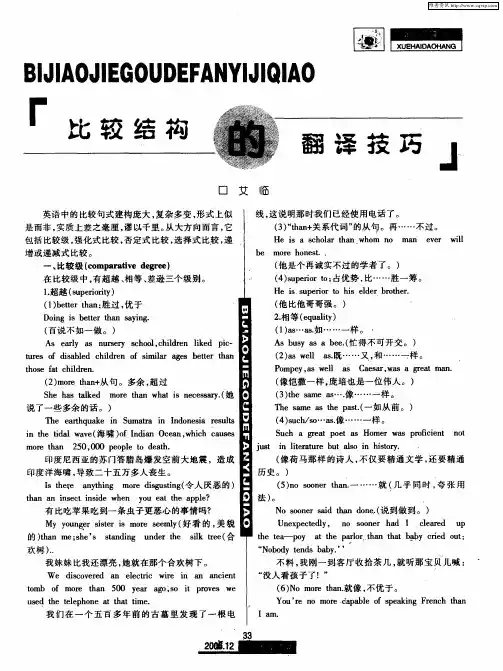
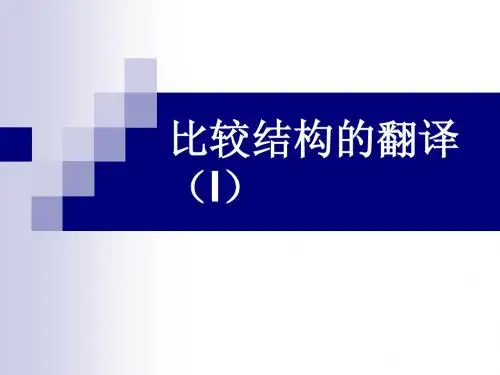
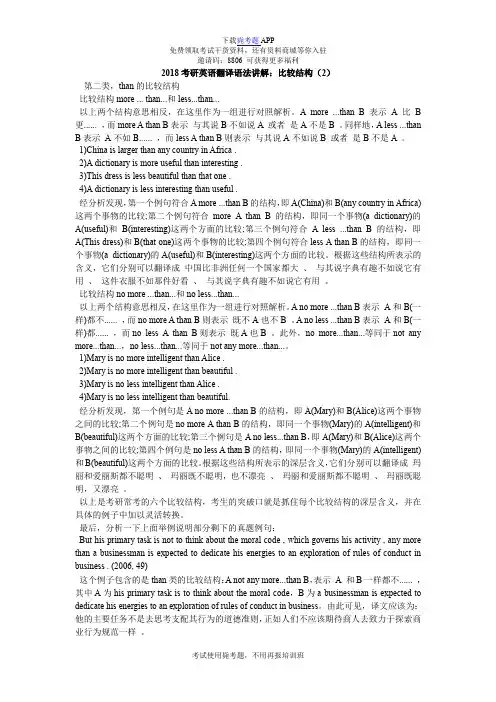
下载毙考题APP免费领取考试干货资料,还有资料商城等你入驻邀请码:8806 可获得更多福利2018考研英语翻译语法讲解:比较结构(2)第二类,than的比较结构比较结构more ... than...和less...than...以上两个结构意思相反,在这里作为一组进行对照解析。
A more ...than B表示A比B 更...... ,而more A than B表示与其说B不如说A 或者是A不是B 。
同样地,A less ...than B表示A不如B...... ,而less A than B则表示与其说A不如说B 或者是B不是A 。
1)China is larger than any country in Africa .2)A dictionary is more useful than interesting .3)This dress is less beautiful than that one .4)A dictionary is less interesting than useful .经分析发现,第一个例句符合A more ...than B的结构,即A(China)和B(any country in Africa)这两个事物的比较;第二个例句符合more A than B的结构,即同一个事物(a dictionary)的A(useful)和B(interesting)这两个方面的比较;第三个例句符合A less ...than B的结构,即A(This dress)和B(that one)这两个事物的比较;第四个例句符合less A than B的结构,即同一个事物(a dictionary)的A(useful)和B(interesting)这两个方面的比较。
根据这些结构所表示的含义,它们分别可以翻译成中国比非洲任何一个国家都大、与其说字典有趣不如说它有用、这件衣服不如那件好看、与其说字典有趣不如说它有用。
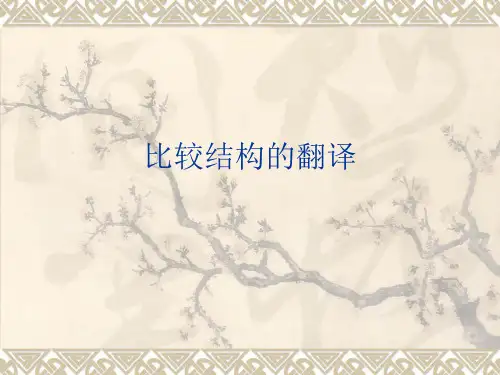
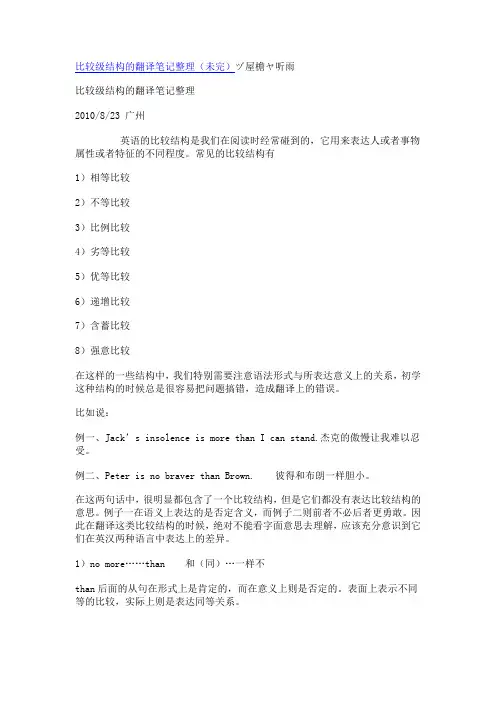
比较级结构的翻译笔记整理(未完)ヅ屋檐ヤ听雨比较级结构的翻译笔记整理2010/8/23 广州英语的比较结构是我们在阅读时经常碰到的,它用来表达人或者事物属性或者特征的不同程度。
常见的比较结构有1)相等比较2)不等比较3)比例比较4)劣等比较5)优等比较6)递增比较7)含蓄比较8)强意比较在这样的一些结构中,我们特别需要注意语法形式与所表达意义上的关系,初学这种结构的时候总是很容易把问题搞错,造成翻译上的错误。
比如说:例一、Jack’s insolence is more than I can stand.杰克的傲慢让我难以忍受。
例二、Peter is no braver than Brown. 彼得和布朗一样胆小。
在这两句话中,很明显都包含了一个比较结构,但是它们都没有表达比较结构的意思。
例子一在语义上表达的是否定含义,而例子二则前者不必后者更勇敢。
因此在翻译这类比较结构的时候,绝对不能看字面意思去理解,应该充分意识到它们在英汉两种语言中表达上的差异。
1)no more……than和(同)…一样不than后面的从句在形式上是肯定的,而在意义上则是否定的。
表面上表示不同等的比较,实际上则是表达同等关系。
这个结构not any more…than ( A is not any more B than X is Y )所传达的意思是一样的,用公式表示,可以看成是A is not B just as X is not Y.Tom is no more fond of playing chess than Jack译文:汤姆和杰克都不喜欢下棋。
Her husband could no more do without her than she could without him.译文:她丈夫离不开她,就像她离不开她丈夫一样。
She is no more a drug addict than I am.译文:就像我不是瘾君子一样,她也不是。
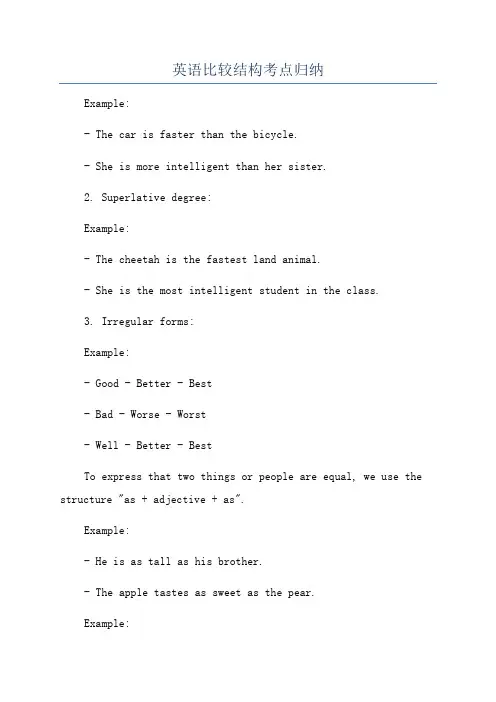
英语比较结构考点归纳Example:- The car is faster than the bicycle.- She is more intelligent than her sister.2. Superlative degree:Example:- The cheetah is the fastest land animal.- She is the most intelligent student in the class.3. Irregular forms:Example:- Good - Better - Best- Bad - Worse - Worst- Well - Better - BestTo express that two things or people are equal, we use the structure "as + adjective + as".Example:- He is as tall as his brother.- The apple tastes as sweet as the pear.Example:- He is taller than me.- She is similar to her mother.Example:- The more you practice, the better you will get.- The faster he runs, the closer he gets to the finish line. Example:- She is faster than other swimmers.- The pink dress is prettier than other dresses in the shop.8. Degree adverbs:Example:- He is much taller than his sister.- The laptop is far more expensive than the tablet. Example:- She has more books than her friend.- I have as many friends as you.Example:- She is the tallest of all her siblings.- This is the most interesting book of the series.。
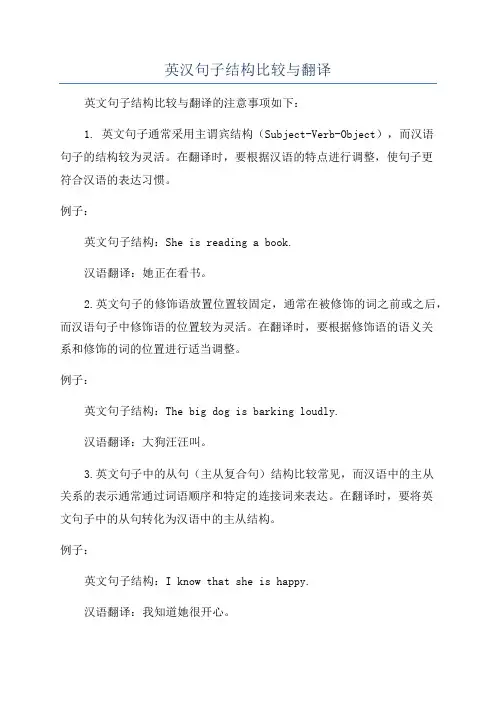
英汉句子结构比较与翻译
英文句子结构比较与翻译的注意事项如下:
1. 英文句子通常采用主谓宾结构(Subject-Verb-Object),而汉语
句子的结构较为灵活。
在翻译时,要根据汉语的特点进行调整,使句子更
符合汉语的表达习惯。
例子:
英文句子结构:She is reading a book.
汉语翻译:她正在看书。
2.英文句子的修饰语放置位置较固定,通常在被修饰的词之前或之后,而汉语句子中修饰语的位置较为灵活。
在翻译时,要根据修饰语的语义关
系和修饰的词的位置进行适当调整。
例子:
英文句子结构:The big dog is barking loudly.
汉语翻译:大狗汪汪叫。
3.英文句子中的从句(主从复合句)结构比较常见,而汉语中的主从
关系的表示通常通过词语顺序和特定的连接词来表达。
在翻译时,要将英
文句子中的从句转化为汉语中的主从结构。
例子:
英文句子结构:I know that she is happy.
汉语翻译:我知道她很开心。
4.英文句子中的倒装结构(句子主语和谓语动词的位置颠倒)较为常见,而汉语中的倒装结构较少使用。
在翻译时,要根据汉语的语法规则进行调整或转换。
例子:
英文句子结构:Not only did she pass the exam, but she also got the highest score.
汉语翻译:她不仅考试通过了,而且还得到了最高分。
总之,翻译英文句子时,要注意句子结构的差异,灵活运用汉语的表达习惯和语法规则,使翻译后的句子更符合汉语的语言特点。
比较结构的特殊译法作者:李雨名来源:《校园英语·上旬》2014年第07期一、Some people have a greater capacity for happiness than others翻译1:有些人比别人更能得到幸福。
翻译2:有些人享得了福,还有些人就享不了福。
翻译本句的困难在于对capacity这个词的理解。
大多死记单词的人都知道它是“能力”,往往并不清楚它主要是指什么能力。
这个词其实有“容积,容量,电容”之义,据此推导,它作“能力”便主要指承受能力或接受能力(即对于某些知识或其它具体或抽象东西的容纳能力)。
而对于本句,直译则为:有些人比别人更有承受幸福的能力,再转译一下,即成为翻译2,所不同之处在于翻译2这种说法更清楚,更符合汉语习惯。
类似汉语的“有些人……,而有些人……”这种结构的句子在英语中可以用比较结构来体现。
再看下句:Some people prefer the company of others to being alone.有些人喜欢有人陪着,而有些人喜欢独处。
二、It is more than (=than what) I can tell翻译1:这比我能讲出的要多。
翻译2:那我就不知道了。
或译为:别的我就不知道了。
More than更多的时候是具有否定意义的。
如本句,直译为:这比我能讲出的要多→我能讲的没有这么多→别的我就不知道了。
再如下句:(1)The police think they are dealing with an ordinary case of robbery but there's more to it than meets the eye.那些警察认为他们处理的是一个普通的抢劫案,但此案背后大有文章。
There's more than meets the eye直译:有比眼睛(看到的)更多(的东西→有些你是从表面看不到的→不只是象表面看到的那么简单→背后大有文章。
英语翻译技巧:比较结构关于英语翻译,不同的人有不同的方法,但是在面对同样的题型的时候,你知道该怎样有效的进行下去吗?下面就和大家分享英语翻译技巧:比较结构,希望能够帮助到大家,来欣赏一下吧。
英语翻译技巧:比较结构从理解与表达的角度来看,比较的形式是次要的,真正重要的是意义上的比较。
只要意义上表示比较,就属于比较句式。
常见的比较结构的意义很容易理解,所以也比较容易翻译,如:I am taller than he.(我比他高)。
因此,这里不再叙述基本比较结构的翻译方法,而主要介绍在意义上容易混淆的比较结构的翻译。
一、as…as…句型(一)as…as…句型as…as…句型是同级比较,表示两者比较程度一样。
所以在翻译的时候,通常翻译为“…和….一样”。
My parcel is as heavy as yours.我的包裹和你的包裹一样重。
She is as much interested in music as ever.她和以前一样对音乐感兴趣。
The economic development in our country is as stable recently as formerly.近,我国的经济发展和以前一样稳定。
(二)not as (or so)…as…句型跟as…as…句型相反的结构not as (or so)…as…表示两者的程度不一样,前者不如后者,所以,通常翻译为“…不如…”。
My uncle is not as (or so) tall as your father.我叔叔不如你父亲高。
People are not so honest as they once were.人们现在不如过去那样诚实了。
(三)not so much …as…句型not so much …as…这个结构表示的基本意义和not as (or so)…as…一样,但是通常翻译为“与其说…不如说…”。
He was not so much angry as disappointed.他与其说是生气,还不如说是失望了。
英汉句法结构对比与翻译
1.主谓结构:英语中主语和谓语动词之间的位置固定,而且一般不允许有其他成分插入;汉语中则允许主谓之间插入状语、宾语等成分,主语通常出现在句首,谓语动词出现在句尾。
英语:He is reading a book.
汉语:他正在看书。
2.宾语结构:英语中宾语通常出现在动词后面,而且一般不允许有其他成分插入;汉语中宾语可以放在动词前面或后面,并且可以有其他成分插入。
英语:She likes to eat apples.
汉语:她喜欢吃苹果。
3.状语结构:英语中状语通常出现在动词后面,表示时间、地点、方式等信息;汉语中状语的位置比较灵活,可以出现在句首、句中或句尾。
英语:He goes to school by bus every day.
汉语:他每天坐公交车去学校。
在进行翻译时,需要根据英语和汉语的句子结构差异进行相应的调整和转换。
具体翻译方法有:
1.主谓结构的翻译:将英语的主语翻译为汉语的主语,谓语动词翻译为汉语的谓语动词。
2.宾语结构的翻译:将英语中的宾语翻译为汉语中的宾语,并根据需要放置在动词前面或后面。
3.状语结构的翻译:将英语中的状语翻译为汉语中的状语,并根据需要放置在句首、句中或句尾。
需要注意的是,不仅要考虑句子结构的差异,还要考虑语言的习惯表达方式和上下文的语境。
对于复杂的句子结构和长篇文章的翻译,还需要进行更加细致的分析和翻译。
比较级(comparative degree)在比较级中,有超越、相等、差逊三个级别。
1. 超越(superiority)(1)better than: 胜过,优于Doing is better than saying.(百说不如一做。
)(2)more than + 从句。
多余,超过She has talked more than what is necessary.(她说了一些多余的话)(3)“than +关系代词”的从句。
再…… 不过。
He is a scholar than whom no man ever will be more honest.(他是个再诚实不过的学者了。
)(4)superior to :占优势,比……胜一筹。
He is superior to his elder brother.(他比他哥哥强)2. 相等(equality)(1) as …as. 如……一样。
As busy as a bee. ( 忙得不可开交)(2) as well as 。
既…… 又,和……一样。
Pompey, as well as Caesar, was a great man.(像恺撒一样,庞培也是一位伟人。
)(3) the same as…. 像……一样。
The same as the past. (一如从前。
)(4) such/ so…as. 像……一样。
Such a great poet as Homer was proficient not just in literature but also in history .(像荷马那样的诗人,不仅要精通文学,还要精通历史。
)(5) no sooner than.. 一……就(几乎同时,夸张用法)。
No sooner said than done.(说到做到。
)(6) No more than. 就像,不优于。
You’re no more capable of speaking French than I am.(你我都不会说日语。